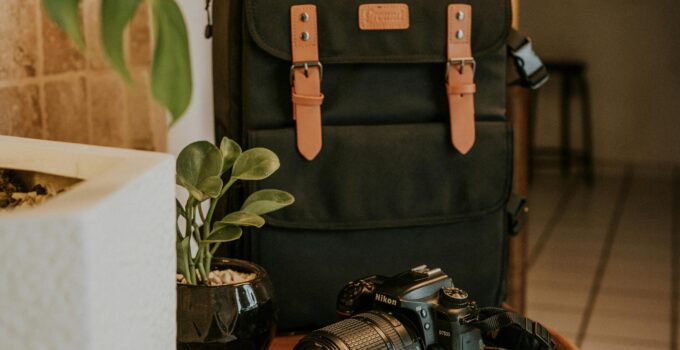Can you wash a Billingham bag? Ever wondered if your beloved Billingham bag can withstand a cleaning routine without losing its charm?
In short, yes, you can wash a Billingham bag. But how exactly should you go about it without risking damage to the material or the bag’s structure?
Discover the best practices, expert tips, and dos and don’ts for safely cleaning your Billingham bag in our comprehensive guide. Don’t miss out on preserving your bag’s quality and appearance for years to come!
Can you wash a Billingham bag?
Yes, you can wash a Billingham bag, but you need to do it carefully to avoid damaging the material. Here’s a simple guide:
Here how to wax a domke bag?

- Empty the Bag: Remove all items from the bag, including any removable inserts or dividers.
- Spot Cleaning: Use a damp cloth with mild soap or a specialized fabric cleaner to spot clean any stains or dirt on the bag’s surface. Gently scrub the affected areas and then wipe with a clean, damp cloth to remove the soap residue.
- Hand Washing: If the entire bag needs cleaning, fill a basin with lukewarm water and add a small amount of mild detergent. Submerge the bag and gently agitate it to loosen dirt. Avoid soaking leather parts excessively. Rinse thoroughly with clean water.
- Drying: Air dry the bag away from direct sunlight or heat sources. Stuff it with towels or paper towels to help it retain its shape while drying.
Following these steps should help keep your Billingham bag clean without causing damage.
Can i wash my Billingham bag in washing machine?
It’s generally not recommended to wash a Billingham bag in a washing machine, especially if it contains leather or delicate materials.
Washing machines can be too harsh and may cause damage or shrinkage to the bag.
However, if your Billingham bag is made entirely of washable materials such as canvas or synthetic fibers without any leather parts, you may consider using a gentle cycle with cold water and a mild detergent.
Place the bag in a mesh laundry bag or pillowcase to protect it during the wash cycle. Avoid using bleach or harsh chemicals.
After washing, remove the bag promptly and reshape it before air drying. Do not tumble dry or expose the bag to direct sunlight or heat sources, as this can cause deformation or fading.
For the best care, refer to the specific cleaning instructions provided by Billingham or consult with a professional cleaner.
Are Billingham inserts washable?
Billingham inserts, such as camera inserts or laptop sleeves, are typically designed to be removable for cleaning or reorganizing your bag’s interior. Whether they are washable depends on the specific material and construction of the insert.
Many Billingham inserts are made from durable and water-resistant materials like nylon or polyester. These materials are often washable, either by hand or in a gentle cycle in the washing machine with cold water and a mild detergent. It’s essential to follow any care instructions provided by Billingham to avoid damaging the insert during washing.
However, inserts that contain padding or delicate components like leather accents may not be machine washable. In such cases, spot cleaning with a damp cloth and mild soap or using a specialized fabric cleaner may be more appropriate.
Always check the care label or contact Billingham directly for guidance on washing your specific inserts.
What happened when you put your Billingham bag into washing machine?
If you put your Billingham bag into a washing machine, several things could potentially happen, depending on the material and construction of the bag:
Here, how to wax your canvas camera bag?
- Damage to Leather or Delicate Parts: If your Billingham bag contains leather components or delicate materials, the washing machine’s agitation and water may cause these parts to shrink, crack, or lose their shape.
- Color Fading: Vibrant colors or dyes on the bag’s fabric may fade or bleed when exposed to water and detergent in a washing machine.
- Tearing or Fraying: The stitching or seams of the bag could weaken or come apart due to the mechanical action of the washing machine.
- Loss of Water Resistance: If the bag has a water-resistant coating, washing it in a machine may diminish this property, making the bag less effective at repelling water in the future.
To avoid these issues, it’s best to follow the manufacturer’s care instructions and opt for hand washing or spot cleaning when necessary.
Things to know before washing your billingham camera bag?
Before washing your Billingham camera bag, there are several important things to know:
- Material Compatibility: Determine if your bag’s materials are suitable for washing. Avoid washing bags with leather components or delicate fabrics unless specified by the manufacturer.
- Removable Inserts: Remove all inserts, dividers, and accessories from the bag before washing to prevent damage or deformation.
- Spot Test: Perform a spot test on a small, inconspicuous area of the bag to check for colorfastness and potential damage from cleaning agents.
- Hand Wash Preferred: Hand washing is often safer than using a washing machine, especially for bags with intricate details or leather accents. Use cold water and a mild detergent.
- Air Dry: After washing, air dry the bag away from direct sunlight or heat sources. Avoid using a dryer, as it can cause shrinkage or damage.
- Follow Manufacturer’s Instructions: Always refer to the care instructions provided by Billingham for specific guidance on washing and caring for your camera bag.
5 steps process to wash your Billingham bag?
Step 1: Prepare the Bag and Workspace
Before beginning the washing process, gather all necessary materials and create a suitable workspace:
- Gather Supplies: Collect a mild detergent, lukewarm water, soft cloth or sponge, and a towel for drying.
- Empty the Bag: Remove all items from your Billingham bag, including inserts, dividers, and accessories.
- Spot Clean Stains: If there are visible stains or dirt patches on the bag’s surface, use a damp cloth or sponge with a mild detergent to spot clean these areas. Gently scrub and then wipe with a clean, damp cloth to remove any residue.
- Check for Damage: Inspect the bag for any loose threads, tears, or damage before washing. Repair any minor damages to prevent them from worsening during the washing process.
Step 2: Hand Washing
Now that your workspace is ready and the bag is prepped, it’s time to hand wash the Billingham bag:
- Fill Basin with Water: Fill a basin or sink with lukewarm water. Avoid using hot water, as it can damage certain materials.
- Add Detergent: Add a small amount of mild detergent to the water. Ensure the detergent is suitable for the bag’s material.
- Submerge the Bag: Submerge the bag in the soapy water, ensuring it is fully immersed.
- Gently Clean: Use a soft cloth or sponge to gently clean the bag’s exterior. Pay attention to areas with stubborn stains or dirt buildup.
- Rinse Thoroughly: Once cleaned, rinse the bag thoroughly with clean water to remove any soap residue.
Step 3: Cleaning Inserts and Dividers
While the bag is being washed, it’s a good opportunity to clean any removable inserts and dividers:
- Separate Inserts: Remove inserts and dividers from the bag.
- Spot Clean: Follow the same spot cleaning process as mentioned earlier for any stains or dirt on the inserts.
- Hand Wash Inserts: If the inserts are washable, you can hand wash them using a mild detergent and lukewarm water. Rinse thoroughly and air dry.
- Air Dry Dividers: For dividers that are not washable, wipe them clean with a damp cloth and allow them to air dry.
Step 4: Rinse and Dry
After washing, it’s essential to properly rinse and dry the bag to avoid damage and mold growth:
- Rinse Thoroughly: Rinse the bag with clean water until all soap residue is removed.
- Remove Excess Water: Gently squeeze the bag to remove excess water. Avoid wringing or twisting the bag, as this can damage its shape.
- Air Dry: Lay the bag flat or hang it in a well-ventilated area to air dry. Avoid direct sunlight or heat sources, as they can cause fading or shrinkage.
- Reassemble: Once the bag is completely dry, reassemble it by inserting the cleaned inserts and dividers.
Step 5: Final Touches
After drying, perform final checks and touch-ups to ensure the bag is ready for use:
- Inspect for Damage: Check the bag for any signs of damage or stitching issues that may have occurred during washing.
- Condition (If Applicable): If your Billingham bag contains leather parts, consider applying a leather conditioner to keep the material supple and moisturized.
- Reorganize: Organize your camera gear or items back into the bag, taking care to arrange them properly with the inserts and dividers.
By following these five steps carefully, you can effectively wash your Billingham bag and maintain its quality and durability for long-lasting use.
5 Steps to wash your billingham insert?
Step 1: Assess the Insert
Before starting the washing process for your Billingham insert, assess its material and structure:
- Material Check: Determine the material of the insert. Billingham inserts are often made of durable and washable materials like nylon or polyester. However, some inserts may contain padding or delicate components that require special care.
- Removable Parts: Check if the insert has any removable parts, such as dividers or foam padding. Remove these components if possible before washing to ensure thorough cleaning.
Step 2: Spot Clean Stains
If there are localized stains or dirt on the insert’s surface, spot cleaning can be an effective initial step:
- Identify Stains: Identify areas with stains or dirt buildup on the insert.
- Spot Clean: Use a damp cloth or sponge with a mild detergent to gently scrub the stained areas. Avoid using harsh chemicals or abrasive materials that could damage the insert’s fabric.
- Rinse: After spot cleaning, rinse the insert with clean water to remove any remaining soap residue.
Step 3: Hand Washing
For inserts that are washable, hand washing is usually the safest method:
- Prepare Washing Solution: Fill a basin or sink with lukewarm water and add a small amount of mild detergent suitable for the insert’s material.
- Submerge the Insert: Immerse the insert in the soapy water, ensuring it is fully submerged.
- Gently Clean: Use a soft cloth or sponge to gently clean the entire surface of the insert. Pay attention to seams and edges where dirt may accumulate.
- Rinse Thoroughly: Rinse the insert thoroughly with clean water to remove all traces of detergent.
Step 4: Drying the Insert
Proper drying is crucial to prevent mold or mildew growth and maintain the insert’s shape:
- Remove Excess Water: Gently squeeze the insert to remove excess water. Avoid wringing or twisting, as this can damage the padding or structure.
- Air Dry: Lay the insert flat or hang it in a well-ventilated area away from direct sunlight or heat sources. Allow sufficient time for the insert to air dry completely.
- Fluff Padding (If Applicable): If the insert contains foam padding that has compressed during washing, gently fluff and reshape the padding while it is still damp.
Step 5: Final Checks and Reassembly
After the insert is dry, perform final checks and reassemble any removable parts:
- Inspect for Damage: Check the insert for any signs of damage, loose threads, or seam issues that may have occurred during washing. Repair minor damages if necessary.
- Reassemble (If Applicable): If the insert has removable dividers or padding, reassemble them according to the original configuration.
- Reinsert into Bag: Once the insert is clean, dry, and in good condition, reinsert it into your Billingham bag. Ensure it fits properly and provides adequate protection for your gear.
By following these steps, you can effectively wash your Billingham insert and maintain its functionality and durability for continued use.
9 methods to wash your Billingham bag without washing machine
1. Hand Washing with Mild Detergent
Hand washing is a gentle method suitable for most Billingham bags, especially those with delicate materials or leather components:
Here, how to clean fabric camera bag?
- Fill a basin or sink with lukewarm water.
- Add a small amount of mild detergent suitable for the bag’s material.
- Submerge the bag in the soapy water and gently agitate to loosen dirt.
- Use a soft cloth or sponge to clean the bag’s exterior, paying attention to stains or soiled areas.
- Rinse thoroughly with clean water to remove soap residue.
- Gently squeeze the bag to remove excess water.
- Air dry the bag away from direct sunlight or heat sources.
2. Spot Cleaning with a Fabric Cleaner
For localized stains or dirt, spot cleaning with a specialized fabric cleaner can be effective:
- Identify the stained areas on the bag.
- Apply a small amount of fabric cleaner directly to the stains.
- Use a soft brush or cloth to gently scrub the stains until they lift.
- Wipe away excess cleaner with a damp cloth.
- Rinse the cleaned areas with water and pat dry with a clean cloth.
- Allow the bag to air dry completely before use.
3. Vinegar and Water Solution
Vinegar is a natural cleaner that can help remove odors and mild stains from your Billingham bag:
- Mix equal parts white vinegar and water in a basin or bucket.
- Dip a soft cloth or sponge into the vinegar solution and wring out excess liquid.
- Gently wipe down the bag’s exterior with the vinegar-soaked cloth, focusing on areas with stains or odor.
- Rinse the cloth with clean water and wipe the bag again to remove vinegar residue.
- Air dry the bag thoroughly.
4. Baking Soda Paste
Baking soda is effective for removing odors and light stains from fabric:
- Make a paste by mixing baking soda with a small amount of water.
- Apply the paste to stained areas of the bag, gently rubbing it in with a soft brush or cloth.
- Let the paste sit for 15-30 minutes to allow it to lift stains and absorb odors.
- Use a damp cloth to wipe away the baking soda paste.
- Rinse the bag with clean water and air dry it.
5. Lemon Juice and Water
Lemon juice is a natural stain remover and deodorizer:
- Mix equal parts lemon juice and water in a bowl.
- Dip a soft cloth or sponge into the lemon juice solution.
- Gently scrub stained areas of the bag with the lemon juice-soaked cloth.
- Rinse the bag with clean water to remove lemon residue.
- Air dry the bag thoroughly.
6. Steam Cleaning
Steam cleaning can effectively remove dirt and refresh your Billingham bag:
- Use a handheld garment steamer or steam iron with a steam setting.
- Hold the steamer a few inches away from the bag’s surface to avoid direct contact.
- Steam the entire bag, focusing on areas with stains or dirt buildup.
- Use a soft cloth to wipe away any loosened dirt or grime.
- Allow the bag to air dry completely.
7. Dry Cleaning
For bags with specific care instructions, professional dry cleaning may be recommended:
- Take the bag to a reputable dry cleaner experienced in handling delicate fabrics.
- Inform the cleaner of any stains or areas needing special attention.
- Follow the dry cleaner’s instructions for pickup and care recommendations.
8. Leather Cleaner and Conditioner (for Leather Parts)
If your Billingham bag contains leather components, use a specialized leather cleaner and conditioner:
- Apply a small amount of leather cleaner to a soft cloth.
- Gently wipe down the leather parts of the bag, focusing on any stains or soiled areas.
- Use a separate cloth to apply leather conditioner, following the product’s instructions.
- Buff the leather with a clean, dry cloth to restore shine and suppleness.
9. Professional Cleaning Services
If unsure about cleaning methods or dealing with tough stains, consider professional cleaning services:
- Research local cleaning services experienced in handling bags and accessories.
- Inquire about their cleaning methods, products used, and any guarantees or warranties provided.
- Follow their instructions for bag drop-off and pickup, and communicate any specific concerns about your Billingham bag.
5 methods to wash your billingham insert?
1. Hand Washing with Mild Soap
Hand washing is a gentle method suitable for most Billingham inserts, ensuring they remain clean without damaging delicate materials:
- Fill a basin with lukewarm water and add a small amount of mild soap suitable for the insert’s material.
- Remove the insert from the bag and immerse it in the soapy water.
- Gently agitate the water to loosen dirt and stains.
- Use a soft brush or cloth to gently scrub the insert’s surface, focusing on soiled areas.
- Rinse the insert thoroughly with clean water to remove soap residue.
- Gently squeeze out excess water and allow the insert to air dry completely before reinserting it into the bag.
2. Spot Cleaning with a Fabric Cleaner
Spot cleaning is effective for targeted stains on inserts without requiring full immersion in water:
- Identify the stained areas on the insert.
- Apply a small amount of fabric cleaner directly to the stains.
- Use a soft brush or cloth to gently scrub the stains until they lift.
- Wipe away excess cleaner with a damp cloth.
- Rinse the cleaned areas with water if needed and pat dry with a clean cloth.
- Allow the insert to air dry completely before using it again.
3. Using a Gentle Detergent Solution
A mild detergent solution can effectively clean inserts without harsh chemicals:
- Prepare a solution of lukewarm water and a small amount of gentle detergent.
- Dip a soft cloth or sponge into the solution and wring out excess liquid.
- Gently wipe down the insert’s surface, focusing on areas with dirt or stains.
- Rinse the insert with clean water to remove detergent residue.
- Pat dry with a clean cloth and allow the insert to air dry completely.
4. Vinegar and Water Mixture
Vinegar is a natural cleaner that can help remove odors and stains from inserts:
- Mix equal parts white vinegar and water in a bowl or basin.
- Dip a soft cloth or sponge into the vinegar solution and wring out excess liquid.
- Gently wipe down the insert’s surface with the vinegar-soaked cloth, focusing on areas with stains or odor.
- Rinse the insert with clean water to remove vinegar residue.
- Pat dry with a clean cloth and allow the insert to air dry completely before reusing it.
5. Steam Cleaning (For Non-Padded Inserts)
Steam cleaning is effective for non-padded inserts, as it can remove dirt and refresh the fabric:

- Use a handheld garment steamer or steam iron with a steam setting.
- Hold the steamer a few inches away from the insert’s surface to avoid direct contact.
- Steam the entire insert, focusing on areas with stains or dirt buildup.
- Use a soft cloth to wipe away any loosened dirt or grime.
- Allow the insert to air dry completely before using it again.
Each of these methods offers a safe and effective way to clean your Billingham inserts, ensuring they remain in good condition for organizing your bag’s contents.
Billingham bag color fainting- 5 tips Revealed
1. Avoid Direct Sunlight and Heat Exposure
Exposure to direct sunlight and heat can accelerate color fading on your Billingham bag. Ultraviolet (UV) rays from sunlight can break down the dyes in fabrics, leading to fading over time. Similarly, heat can cause colors to fade more quickly, especially in darker shades.
To prevent color fading, store your Billingham bag in a cool, shaded area away from direct sunlight and heat sources such as radiators, heaters, or car interiors. When outdoors, consider using a bag cover or placing the bag in the shade to minimize UV exposure.
2. Use Fabric Protectants
Fabric protectants or UV protectant sprays can help prolong the vibrancy of colors on your Billingham bag. These products create a protective barrier that shields fabrics from UV rays, moisture, and stains. Before applying any protectant, test it on a small, inconspicuous area of the bag to ensure compatibility and no adverse effects.
Follow the manufacturer’s instructions for applying the fabric protectant, and reapply as recommended to maintain its effectiveness. Regular application of fabric protectants can help preserve the colors of your bag and extend its lifespan.
3. Gentle Cleaning Methods
When cleaning your Billingham bag, opt for gentle cleaning methods to minimize color fading. Avoid harsh chemicals, bleach, or abrasive cleaning tools that can strip away dyes and cause discoloration. Instead, use a mild detergent or specialized fabric cleaner suitable for the bag’s material.
For spot cleaning, dilute the detergent in lukewarm water and use a soft cloth or sponge to gently clean the affected areas. Rinse thoroughly with clean water and pat dry with a towel. Avoid rubbing or scrubbing vigorously, as this can damage the fabric and contribute to color fading.
4. Rotate and Store Properly
If you own multiple Billingham bags or use your bag seasonally, consider rotating them regularly to distribute usage and prevent uneven color fading. Alternating between different bags allows each one to “rest” and reduces the wear and tear on a single bag.
When storing your Billingham bag, use a dust bag or cover to protect it from dust, moisture, and light exposure. Ensure the storage area is well-ventilated and free from humidity, as excessive moisture can also contribute to color fading and mold growth.
5. Follow Manufacturer’s Care Instructions
Lastly, always refer to the manufacturer’s care instructions provided with your Billingham bag. These guidelines are tailored to the specific materials and construction of your bag, offering valuable insights into proper care and maintenance to prevent color fading and preserve its appearance.
Follow any recommended cleaning methods, storage tips, and product recommendations outlined in the care instructions. If in doubt, contact Billingham directly for personalized advice on caring for your bag and maintaining its color vibrancy.
Related faq’s
Can you wash your purse in the washing machine?
It’s generally not recommended to wash a purse in a washing machine unless the care label specifically states it’s safe. Washing machines can be too rough, causing damage to delicate fabrics, straps, or embellishments.
Instead, opt for spot cleaning with a damp cloth and mild soap for stains or use a specialized fabric cleaner if needed.
If the purse is machine washable, place it in a mesh laundry bag on a gentle cycle with cold water and mild detergent.
Always check the care instructions provided by the manufacturer to ensure proper cleaning without risking damage.
Can I wash my Billingham bag in a washing machine?
Washing a Billingham bag in a washing machine is generally not recommended, especially if the bag contains leather components or delicate materials. Machine washing can be too harsh and may cause damage or shrinkage to the bag. It’s safer to opt for hand washing or spot cleaning to preserve the bag’s quality.
How should I clean my Billingham bag if it gets dirty?
For general cleaning, spot cleaning with a damp cloth and mild soap or using a specialized fabric cleaner is recommended. Avoid using harsh chemicals or abrasive tools that could damage the bag’s material. Always test any cleaning products on a small, inconspicuous area first to ensure compatibility.
Can I wash the removable inserts or dividers in my Billingham bag?
Yes, many Billingham inserts, such as camera inserts or laptop sleeves, are designed to be removable and washable.
However, it’s essential to check the care label and follow the manufacturer’s instructions for washing these inserts. Hand washing with a gentle detergent and air drying is typically recommended.
How often should I clean my Billingham bag?
The frequency of cleaning your Billingham bag depends on how frequently you use it and the level of dirt or stains it accumulates.
Generally, spot cleaning as needed and occasional gentle cleaning to remove dirt buildup is sufficient. Avoid overwashing, as excessive cleaning can also contribute to wear and tear on the bag’s materials.
Conclusion:
In conclusion, while you can wash some components of a Billingham bag like removable inserts or dividers, washing the entire bag, especially in a washing machine, is generally not recommended.
The delicate materials and construction of Billingham bags are better suited for gentle cleaning methods such as hand washing or spot cleaning with mild soap or fabric cleaner.
Following the manufacturer’s care instructions and avoiding harsh chemicals or abrasive cleaning tools will help maintain the quality, appearance, and longevity of your Billingham bag.








